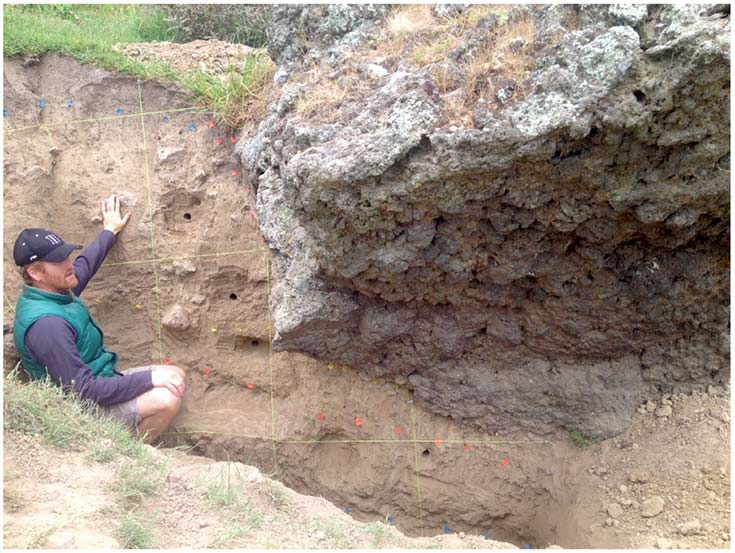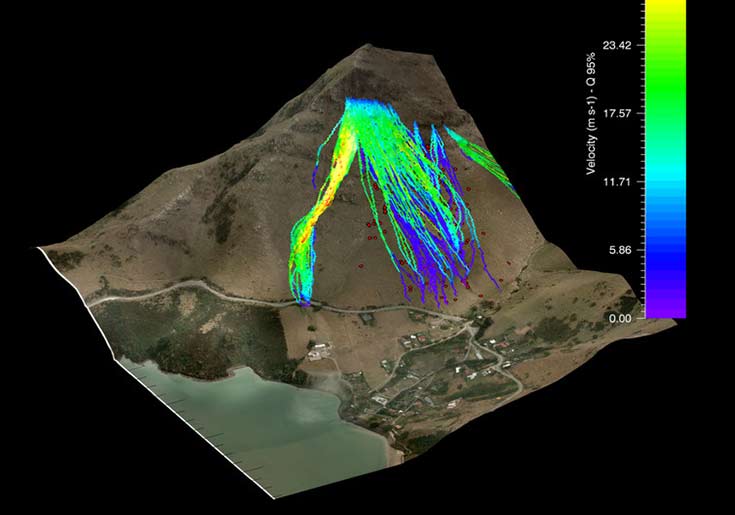Humans can make rockfalls from earthquakes more dangerous
Mark Quigley of the University of Melbourne and Josh Borella, University of Canterbury, describe new research in an article first published in The Conversation.
Earthquakes (including the tsunamis they generate) are Earth’s most fatal natural hazard, accounting for approximately 55% of the more than 1.35 million disaster deaths in the last two decades. The US Geological Survey predicts that more than 2.5 million people will die from earthquakes this century alone.
So anything that can be learnt from past earthquakes to reduce death tolls and damage is welcome.
Most fatalities and injuries in earthquakes result from damage and collapse of buildings, houses and other urban infrastructure exposed to strong seismic ground shaking.
The most lethal combinations occur when large populations with vulnerable infrastructure are exposed to strong and frequent earthquakes.
A poignant example of a disastrous convergence of these factors is the magnitude 7 earthquake near Port-au-Prince, in Haiti, in 2010. More than 150,000 are now thought to have died from the earthquake or in the following six-week period due to injuries or illness.
Other examples of seismologically risky ticking time bombs include Tehran and Istanbul, where large fatalities are expected in future earthquakes.
Deadly rockfalls
Landslides and other mass movements, such as rockfalls, are another important cause of earthquake fatalities. In the magnitude 7.9 Wenchuan earthquake in China in 2008, landslides caused more than 20,000 of the estimated 80,000 fatalities.
Landslides caused approximately 26,000 fatalities in the magnitude 7.6 Kashmir earthquake in 2005. Of the 185 fatalities in the magnitude 6.3 earthquake at Christchurch in New Zealand in 2011, five were caused by rocks that hit people after falling from steep basaltic bedrock cliffs.
In the aftermath of the Christchurch earthquakes, the annual fatality risk posed by future rockfalls was calculated by a team led by GNS Science for individuals living in areas of Christchurch susceptible to mass movements. Some residents were estimated to have a greater than 1 in 1,000 annual chance of dying from future rockfalls.
Following the public release of maps and reports, a thorough process was undertaken to clarify the proposed land use planning boundaries considered in the Christchurch Replacement District Plan. This included panel hearings, that included experts and welcomed public submissions.
Important elements to consider in the context of future rockfall risk include the frequency of rockfalls and the maximum distance that rocks might travel if they are dislodged from a cliff.
Our new research, when combined with other recent studies in this region, examines these elements in detail and provides some interesting results.
Falling boulders
We have been researching the Rapaki rockfall site, where hundreds of rocks fell and rolled downslope in the 2011 Christchurch earthquakes, since 2011.

Co-author Josh Borella taking the measure of a prehistoric boulder (photo: Mark Quigley)
Two PhD students, one postdoctoral researcher, many domestic and international researchers and hundreds of undergraduate students have conducted research at the site. It is now one of the most extensively studied and analysed geologic sites in all of New Zealand.
Using field studies, laser scans, air photos and drones, we mapped more than 1,000 individual rocks that were present on this hillslope prior to the 2011 earthquakes.
We measured the distances of the 2011 and pre-2011 boulders from the source cliff to determine how far they travelled. The pre-2011 boulders appear on the oldest aerial photographs of the areas and local residents claim they have been on the hillslope as long as they can remember.
These prehistoric rocks are partially embedded in hillslope sediment and are weathered with lichen covered surfaces. They have the same volumetric characteristics and are comprised of the same rock types that fell in 2011.
Geochemical and geochronological studies of the prehistoric rocks and the sediments within which they reside indicate the most recent severe rockfall event in the Rapaki area of Christchurch occurred many thousands of years ago. Our best estimate of this timing is 6,000 to 8,000 years before present.
But what was perhaps most intriguing was that a significant population of the modern boulders travelled further downslope (more than 150 metres) than their most travelled prehistoric counterparts.
A comparison of rockfall for both prehistoric and modern boulders (photo: Josh Borella) We used numerical models to simulate the trajectories of modern boulders and compared these to the prehistoric ones. To get a better fit for the prehistoric boulder locations, we added vegetation to the hillslope in our models and re-ran them.

Modelling shows the location of simulated boulders when drag force attributed to native forest is applied correlates well with mapped prehistoric boulder distributions (photo: Louise Vick)
Our hypothesis is that the prehistoric rockfall events occurred when self-regenerating native forest was present on the currently deforested grassy hillslope. The impacts of falling boulders with native bush and forest slowed boulder velocities and reduced their travel distance.
Our extensive studies at Rapaki including radiocarbon dating reveal evidence for 17th to 20th century burning and changes in hillslope erosion rates between the prehistoric and modern rockfall events.
Large scale deforestation of Banks Peninsula, beginning with Maori arrival in the area and continuing during European settlement, may have inadvertently increased rockfall hazard by removing the natural vegetative barrier that previously impeded boulder travel.
Lessons to be learnt
The Scottish geologist James Hutton is often regarded as one of the founding fathers of geology. In his 1795 work, In Theory of the Earth, he writes: "In examining things present, we have data from which to reason with regard to what has been; and, from what has actually been, we have data for concluding with regard to that which is to happen thereafter."
This idea was subsequently expanded upon by fellow Scot Charles Lyell in his Principles of Geology (1830), and now underpins what is commonly referred to in science circles as the uniformitarianism principle.
Put simply, if things have happened in the past then they can happen again in the future in much the same way and with the same impact.
In seismic hazard analysis, we often use geologic records of past earthquakes and their associated phenomena to predict the most likely characteristics of future events.
A lesson from our Christchurch example is that we need to consider any landscape changes made in an earthquake-prone area and how these might cause future events to deviate somewhat from those of the past. This includes those landscape changes made by humans.
On the plus side, our study provides evidence that native revegetation of some of the slopes most affected by severe rockfalls in Christchurch has the potential to reduce the travel distance of future rockfall events.
A variety of other approaches including land use changes, such as red zoning the riskiest areas, and engineering solutions may also reduce rockfall risk.
Some of these have been well implemented in Christchurch, such as scaling off loose boulders, caging and bolting susceptible rock outcrops and building barriers such as rock cages and walls. Non-native trees such as pines have also proved somewhat effective in reducing rockfall hazard.
Hopefully these lessons will travel well throughout New Zealand and the world, with an aim of reducing future fatalities and loss from rockfalls caused by earthquakes.
[The Conversation] Mark Quigley, Associate professor, University of Melbourne and Josh Borella, PhD candidate in geology, University of Canterbury
This article was originally published on The Conversation. Read the original article.
Josh Borella, 30/09/2016